Whisky collecting has rapidly become considered to be a lucrative and dynamic investment opportunity both in Australia and around the world, and one of the most common ways to buy these whiskies is at auction.
As an investment, whisky bottles increase in value at an average of about 10% annually, which beats out many other investment opportunities. Many bottles of whiskies bought at auction appreciate even more: the 2016 The Macallan 18-Year-Old Single Malt Scotch Whisky went from 1,300 AUD to 2,000 AUD between 2021 and 2022.
If you’ve never bought whisky at auction before, the process might seem intimidating at first as is the case with making any new investment. The first step to demystifying whisky auctions is to do your due diligence and equip yourself with plenty of market knowledge through preliminary research.
And if you’re serious about buying whisky at auction, this Whisky Auctions Beginners Guide is a good starting point. We’ll go through the ins and outs of bidding at a whisky auction, as well as how to prepare beforehand and what to do after the auction is finished.
Do Your Research On The Whisky You Plan To Buy At Auction
As with any other collectible, the first step to buying whisky at an auction is to do your research. Begin by gaining an understanding of what whisky is and what factors affect its price. These factors include:
- Whether or not the whisky being auctioned comes in its original packaging.
- The age of the whisky bought at auction – traditionally, ‘milestones’ where whiskies experience significant jumps in value are at 8, 10, 12, 15, 18, 21 and 25 years.
- Where the whisky you’re bidding for was distilled – the value placed on particular distilleries changes with time and collectors’ shifting tastes.
- Alcohol content – whisky needs to have 40% alcohol content or more. Anything with less has no value and is not worth bidding for at auction.
- Public demand and the number of potential bidders for a particular whisky bottle.
Once you’ve identified what types of whisky you’d be interested in buying, look up an auction calendar to see if there are any whiskies you’d like that are available at auction in the near future.
Set A Bid Limit For A Particular Whisky Auction
To avoid paying too much when buying whisky at auction, setting a bid limit, or a ‘hammer price’, is essential. This is the maximum price you’re willing to bid for a particular bottle of whisky. While the process of bidding at a whisky auction can get exciting, it’s important not to let your emotions get the best of you and to stick to your hammer price.
Your hammer price will depend on your goals, the bottle of whisky you’re bidding for, the competition at the auction and more. Estimate the value of the whisky bottle by looking up how much other such bottles sell for in other auctions.
Your maximum bid for a bottle of whisky might be at, slightly below or above its market price. When deciding how much to bid for whisky at auction, the factors mentioned earlier, like distillery and age, should also be taken into account.
Remember to factor in the add-ons you’ll need to pay on a bottle of whisky on top of your successful bid price. If you’re buying from an auction site like Cellar Vault, remember that you’ll need to pay a 10% brokerage fee on top of the final price of your whisky.
At the end of the day, the value of a whisky is what somebody else is willing to pay for it. Sometimes the aforementioned go out of the window and some bottles attract a bidding war shooting the final price way above reserve.
Buy Your Whisky At An Auction
Now that you’ve identified the sort of whisky you’re in the market for, how much it’s worth and how much you intend to bid on that whisky, it’s time to attend your first auction.
Thanks to the internet, it’s possible to buy whisky at live online auctions. We recommend reading through buyer reviews and assessing prices recorded in past auctions to validate the legitimacy of bidding sites as well. It’s also important to find a whisky auction site that offers secure shipping to ensure that your new investments can be sent to you promptly and in good condition.
Remember not to panic when bidding for whisky at auction. Live online whisky auctions can last days, and rather than spending time and energy bidding in the early stages, plenty of collectors choose to wait for the last few hours before bidding for whisky.
Pay For And Care For Your Whisky After A Successful Bid At Auction
Congratulations on your new bottle of whisky! After winning the bidding for whisky at an auction, you’ll need to settle the payment within a number of days set by the auction platform. The timeline is typically 5-10 days after buying your whisky at an auction.
Once you’ve successfully bought that bottle of whisky you’ve had your eye on, you’ll want to know how to look after the whisky to ensure it stays in great condition and you can resell it in the future at a favourable price. Remember, buying whisky at auction can be a lucrative hobby, provided the bottle of whisky you’ve bought doesn’t deteriorate.
Store your whisky in a dark, cool location. More experienced whisky buyers often allocate an entire room to their whisky collection. If the whisky you bought at auction came in a box, do not get rid of the box. Keeping the original box of your whisky can boost its value by 30%.
~
Whisky collecting is a fun – and potentially lucrative – hobby, and you can expect rare whisky bottles to rise further in price as more people take up buying whisky at auctions. Following these tips ensures that you don’t overpay for that dream bottle of whisky and raises your chances of success when attempting to buy whisky at auction.
There’s actually a long and sometimes bumpy history when it comes to whisky production in Australia – a history that stretches from the first few distilleries that popped up in Tasmania (or Van Diemen’s Land at the time) in the 1820’s and all the way through to the thriving domestic whisky market that we are today.
While whisky had been imported into Australia well before the early 1800’s via Scottish and Irish migrants and traders, Australian whisky history can be said to have truly started in Tasmania in the 1820’s, which is where we begin our tale.
The Beginnings Of Australian Whisky History In Tasmania
As we’ve mentioned, the history of whisky production in Australia officially started in 1822 in Hobart, in what was then known as Van Diemen’s Land. The first whisky distillery in Australia was the Sorrell Distillery, which was soon followed by 16 other whisky distilleries around the area. Tasmania, which at the time was a producer of barley, was the perfect starting point for the formal production of whisky in Australia.
Then, for reasons of public morality, Governor John Franklin passed the Distillation Prohibition Actin 1839, which outlawed the production of whisky in Tasmania and was a major roadblock in the growth of Australia’s budding domestic whisky market. Franklin passed the act on the advice of his wife, who thought that whisky made men “act like pigs”. Simply put, this was a dark time in the history of Australian whisky.
Sadly, the Distillation Prohibition Act was not repealed for more than a century, which means that not another bottle of whisky was produced legally in what should have been the perfect region for whisky production until 1990.
The Victorian Distillation Act Of 1863: Larger Whisky Distilleries In Australia
Australian whisky history didn’t stop after the enactment of the Distillation Prohibition Act. Smaller distilleries, like Robert Cooper’s Brisbane Distillery and Sir William Milne and John Disher’s Milne and Co. Distillers, continued the production of whisky in Australia on a smaller scale. However, it wasn’t until the Victorian Distillation Act of 1863 that Australia began to see larger distilleries again.
The Victorian Distillation Act of 1863 aimed to place tighter regulations on the production of whisky in Australia, which put many smaller whisky distilleries out of business. Shortly after the act was passed, John Dunn opened the Warrenheip Distillery in Warrenheip, a suburb near Ballarat. Warrenheip, being a full-scale distillery, marked a significant point in Australian whisky history. The Warrenheip Distillery was later renamed Milne and Co. Distillers. As an interesting aside, bottles of Milne and Co. Distillers whisky still exist today, and you’ll occasionally find them at whisky auction sites.
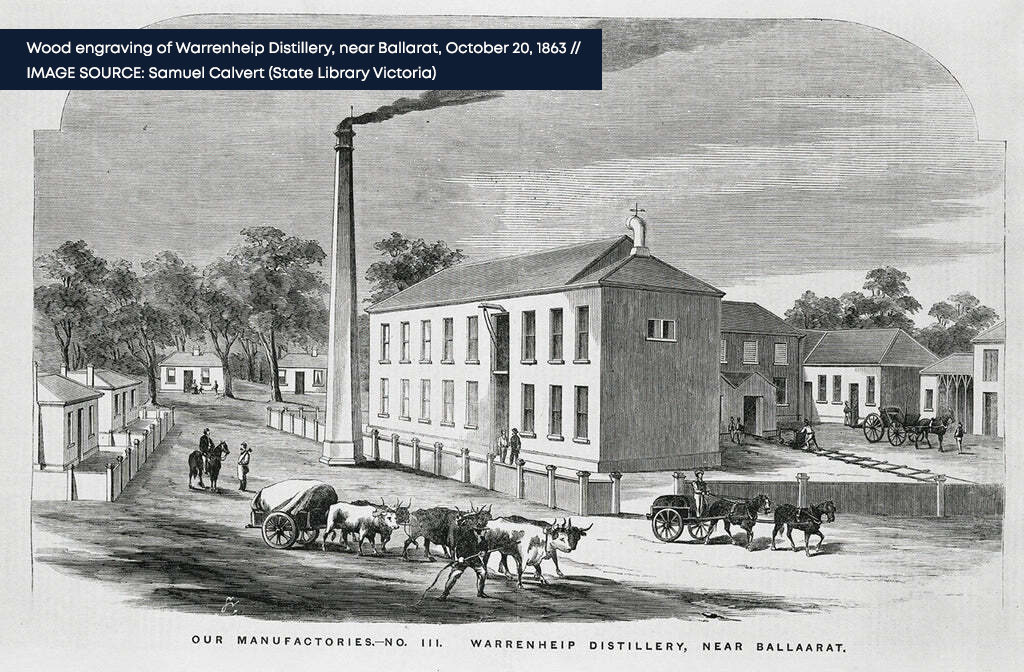
In 1884, over 20 years after the first large-scale Australian whisky distiller post-Distillation Act was created, the Joshua Brothers opened the Federal Distillery in Melbourne. At the time, the Federal Distillery was the largest whisky distillery in Australia and the third largest anywhere in the world. The Australian whisky distillery cost an estimated 150,000 British pounds, or roughly 40 million Australian dollars in today’s money, to open. The Federal Distillery truly put Australian whisky on the world map.
In 1924, the Federal Distillery joined forces with Henry Brinds and Co. (formerly the Warrenheip Distillery), Kennas Pty Ltd and Brehney Brothers to form Federal Distilleries Pty Ltd.
The Entrance Of British Companies Into The Australian Whisky Scene
Having seen Australia’s potential as both a producer and a consumer of whisky, English and Scottish distilleries decided to set up shop in the country. In 1928, the Distillers Company of Edinburgh (now part of Diageo) set up the Corio Distillery, which produced 500,000 gallons of whisky a year and was the largest whisky distillery on Australian shores, comfortably beating out the Federal Distillery.
Not to be outdone by their northern neighbours, the English company Gilbey’s of London opened their own distillery in Melbourne while purchasing Milne and Co. Thanks to tariffs designed to support the production of Australian whisky, the Corio Distillery and Gilbey’s distilleries were able to sell their whiskies for 40% less than foreign whiskies.
Due to their price advantages, the Distillers Company of Edinburgh and Gilbey’s of London set out to dominate the lower-end whisky market in Australia. They did this by creating blended whisky, which is generally of a lower standard than single malt whisky. This led to a period of low-quality Australian whisky until the tariffs were repealed in the ‘60s.
Whisky In Australia Today
Today, Australia is one of the world’s top whisky producers, both in terms of overall volume and number of whisky distilleries. Australia is also a major consumer of whisky, and the market is expected to keep growing over the coming years.
After having closed many of its distillery doors for over a century following the passing of the Distillation Prohibition Act, Tasmania has once again become a whisky powerhouse in Australia. In fact, many of Australia’s most iconic whisky distilleries, including LARK Distillery, Sullivans Cove Distillery and Hellyers Road Distillery are located on the island of Tasmania, humbly continuing the work that had begun all the way back in the 1800’s with Australia’s first whisky producers.
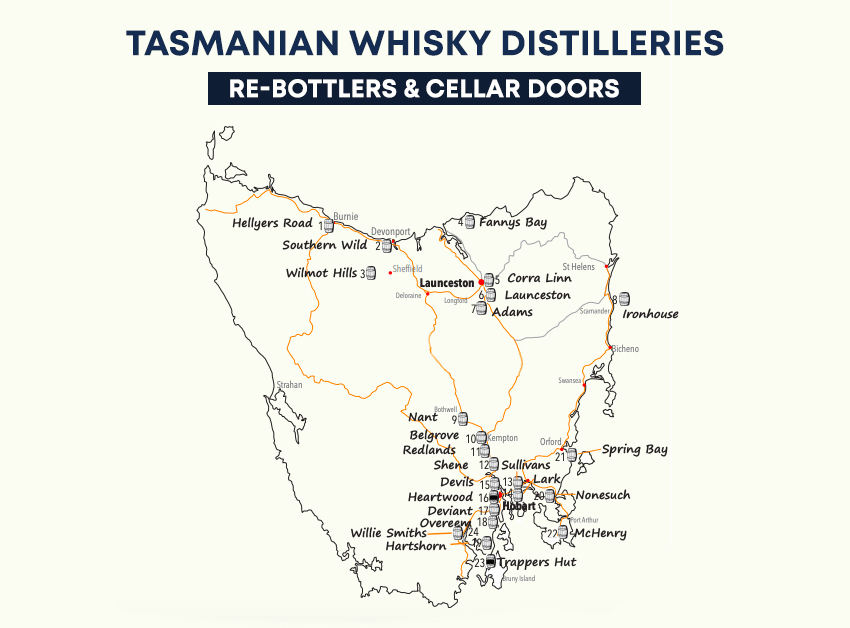
The Rise of Modern Distilleries: Starward and Archie Rose
In the landscape of Australian whisky, newer distilleries like Starward and Archie Rose have carved out niches in an industry that allows for innovation. These distilleries not only pay homage to traditional distilling methods but also incorporate unique, local twists that reflect Australia’s vibrant culture and resources.
Starward Distillery, based in Melbourne, was founded in 2007 by David Vitale with a vision to create a distinctly Australian whisky. What sets Starward apart is its commitment to using entirely Australian barley and maturing the whisky in red wine barrels sourced from local wineries. This not only imparts a unique flavour profile characterised by rich and fruity notes but also showcases the synergy between different aspects of Australian agriculture. Starward’s offerings have been warmly received, gaining recognition both domestically and internationally for their innovative approach. They even had a collaboration with legendary distillery Lagavulin from Islay.

Archie Rose Distilling Co. in Sydney, established in 2014, emphasizes craftsmanship and local sourcing. Archie Rose has been pivotal in urban craft distilling in Australia, offering a hands-on approach that allows for the customisation of spirits at the distillery. Their whiskies are crafted using a variety of malted grains, including local barley, rye, and wheat, contributing to complex flavour profiles that have garnered numerous awards. Their commitment to sustainability and innovation is evident in their use of native botanicals and grains, pushing the boundaries of traditional whisky production.
Both distilleries exemplify the evolution of the Australian whisky industry. They blend tradition with bold new techniques and flavours. With the ability to provide cost-effective sprits to consumers at all levels of their whiskey journey, they are setting the stage for a future where Australia’s whisky is as diverse as its landscape.
Secure Your Own Piece of Australian Whisky History At Cellar Vault
You’ll be pleased to know that you can own your very own piece of Australian whisky history. As we mentioned, many rare bottles of whisky from historic distilleries like Milne and Co. Distillers will still occasionally turn up at whisky auctions in Australia. You just need to know where to look for them and how to buy them securely.
Owning a historic bottle of Australian whisky can also be a surprisingly lucrative investment. Whisky collecting is a hobby with a massive following, and rare whisky bottles often appreciate in price significantly. To snare your own piece of Australian whisky history, hop on to the latest auction at Cellar Vault today and see what bottles of rare Australian whisky are up for sale.
When it comes to collectibles, a bottle of whisky might seem like an unusual choice. But if you know what you’re looking for, these amber bottles can be a fascinating choice for collectors.
Thanks to the limited global supply of high-end whiskies paired with the unique qualities and flavour profiles of individual batches, it’s possible for collectors to stumble on rare gems. For instance, in 2022, a 1975 cask of Ardberg sold for almost 30.5 million AUD. This should give you an idea of the value collectors place on whisky. The fact that many collectible whisky bottles are no longer in production further heightens the rarity – and value – of the most sought-after bottles.
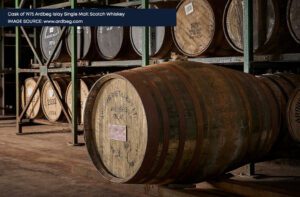
An Overview Of Whisky Collecting As A Hobby
There’s no question that whisky collecting is a massively popular hobby. The market for Scotch, which is whisky that comes from Scotland, alone is projected to rise to 52.1 billion AUD in 2024. When all types of whisky are taken into account, the global market is estimated at 98.6 billion AUD as of 2024. Today, much of the demand for collectible whisky comes from investors from larger Asian markets like China, India and Japan.
There are many reasons to get into whisky collecting. For one thing, adding a rare bottle of whisky to your collection allows you to appreciate the craftsmanship that went into making it. There are many steps, from harvesting the grain to bottling the whisky, that go into each and every bottle you hold in your hands.
Whisky collecting is also a social hobby. Attending whisky auctions, whether online or physically, allows you to interact with like-minded collectors. You can also join in-person and digital whisky communities that allow you to discuss, ask questions about and share pictures of rare bottles of whisky. There are also now successful whisky festivals like Whisky Abbey that take place every year.
If you’re looking to build your whisky collection from scratch, you can either buy whisky by the bottle or by the cask. In the following sections, we’ll explore how to go about collecting bottles and casks respectively, as well as the pros and cons of each option.
Collecting Bottled Whisky
If you’re just getting started in the world of collecting whisky, you’re best off buying whisky by the bottle. But how do you buy whisky as a collector? As with any high-end product market, you can participate in auctions to bid on professionally valued bottles. Alongside attending live whisky auctions, you can also buy whisky bottles as an investor by shopping at whisky retail websites or buying directly from fine and rare whisky specialists. Once again, just ensure you do background research on any retailers or independent sellers you invest with.
Buying whisky by the bottle is the most popular way to collect whisky. Purchasing bottles of whisky allows you much more flexibility than buying casks, as you don’t need to wait for the whisky to mature. Whisky stored in bottles does not age, giving you the freedom to hold onto your whisky as long as you want. Store your whisky bottles upright in a cool, dark place with a consistent temperature to prevent evaporation and preserve their quality.
Some of the top whisky bottles to collect currently include the Hibiki 21 Years Old, the Balvenie Tun 1509 Batch 7, the Springbank 25 Year Old, and the Macallan Double Cask 18 Years Old. Distilleries producing some of the most collectible whiskies include Macallan, Lagavulin, Laphroaig Springbank, Ardbeg with Bourbon distilleries like Pappy Van Winkle, Colonel E.H Taylor and Mitchers also doing well in recent times.
Keep an eye out for whether bottles are either straight from the distillery or from a reputable independent bottler to verify their authenticity and quality.
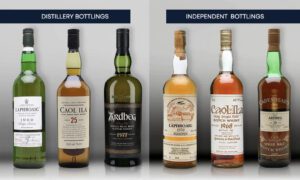
There are many factors that go into whether or not a bottle of whisky makes for a good addition to your collection. As mentioned, the distillery impacts whisky’s desirability. Age is another factor, as is market demand for a specific bottle or distillery or even the quality of the whisky inside the bottle. The Bowmore Black is a good example of a well-known distillery with an aged statement whisky that has fantastic reviews on nose, taste and finish and would make a fantastic addition to any whisky collection.
Whether you’re bidding on a whisky bottle to add to your collection or buying one from a store, you want to make sure to get a good price. The factors mentioned above all go into the value of a bottle of whisky and can help you decide whether or not a particular whisky makes for a good buy at a certain price. It’s also worth looking over past auctions to determine roughly how much a bottle of whisky that you’re interested in adding to your collection should cost you.
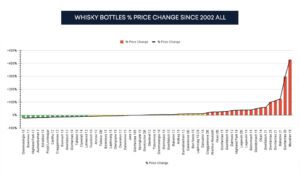
Collecting Casks Of Whisky
The second primary way of collecting whisky is to buy casks from a distillery. This is typically done through a broker, who buys whisky straight from distilleries like Macallan and sells them to private collectors like yourself.
The main reason to collect whisky by the cask is that it allows you to buy whisky at a lower price point than fully mature whisky. When stored in casks, whisky will continue to age and improve in taste and quality. Collecting casks of whisky gives you the satisfaction of witnessing your whisky mature over time.
Collecting whisky by the cask is not for beginners, however. Because you’ll be buying an entire cask of whisky, prices will typically start at over 7,000 AUD, making it a more capital-intensive purchase. It’s also harder to sell a cask of whisky than it is a bottle.
Casks of whisky are also harder to source than bottles. Rather than bidding for whisky bottles in the flesh or on online platforms, you’ll need to find a broker with connections to whisky distilleries.
~
If you’re looking to collect whisky, you’ll want to look at online auctions. Learn how to buy and sell whisky through platforms like Cellar Vault and grow your whisky collection today. Alongside providing free valuation services for prospective sellers, Cellar Vault also offers secure domestic and international shipping, shipping insurance and secure packaging.
While there’s a lot to learn about the world of collectible whisky, the effort is well worth it. Finding and buying rare whiskies and growing your whisky collection is one of the coolest and most satisfying hobbies out there.
What are you waiting for? Do your research, look up upcoming auctions, and grow your collection of rare whiskies today.
